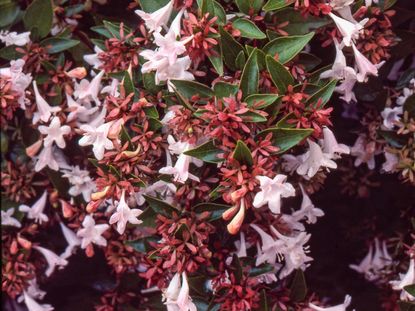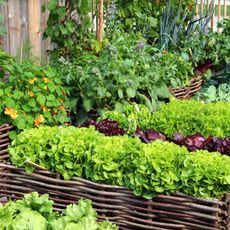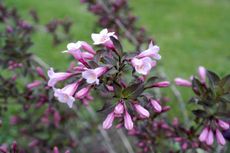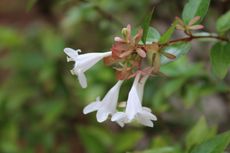Planting Abelia Bushes - Tips For Growing And Caring For Abelia Plants


Abelia shrubs are one of those old-fashioned plants that became popular because of interesting foliage, showy flowers, reliable performance, and simple abelia care. Learn how to grow abelia in your landscape for these characteristics. Newer cultivars of the glossy abelia plant provide a range of colors and forms.
Abelia shrubs, Abelia grandiflora, have attractive foliage, which partially accounts for their longtime use in the landscape. The evergreen abelia has red foliage throughout the summer, becoming even deeper and more brilliant in autumn through winter.
Flowers offer several bursts of bloom from spring to fall, with clusters of fragrant and frilly pink and white tubular flowers. In colder areas of the country, the glossy abelia plant is considered semi-evergreen, as it may lose half its leaves in cold winters.
How to Grow Abelia
When planting abelia in your yard, choose a prominent spot, as abelia shrubs are no longer just to hide the foundation of your home. Also, choose a spot that gets full to partial sun. The glossy abelia plant grows in a variety of soil types but responds best to a fertile soil amended with organic material.
Abelia Care and Pruning
Little is needed with regards to the care of these shrubs, though regular watering improves performance. When growing the standard Abelia grandiflora, leave room for the plant to spread to 6 feet (2 m.) and reach 6 to 10 feet (2-3 m.) in height. The habit of the glossy abelia plant is to spread. Newer cultivars are more compact and require less pruning, therefore, abelia care is less time consuming.
- 'Lavender Mist' spreads only slightly, with gray-green foliage that becomes a purplish red in fall and a deep purple in winter. Blooms on these compact abelia shrubs are lavender and white, with two heavy bloom periods in June and August. Prune this abelia in early spring once established.
- 'Plum Surprise' is another of the newer offerings, with less flowering and more finely textured foliage. Arching stems sport yellow-green leaves which become emerald in summer, turning burgundy as temperatures cool. Reddish stems often bear single flowers that appear white on first glance, but when examined closely, have a purple blush and yellow throat. This glossy abelia plant is tolerant of drought and summer heat once established in the landscape. Abelia care for this cultivar includes early spring pruning.
Now that you've learned how to grow abelia and the diversity of its cultivars, add one or more in your yard. Planting abelia will be an asset to your landscape.
Gardening tips, videos, info and more delivered right to your inbox!
Sign up for the Gardening Know How newsletter today and receive a free download of our most popular eBook "How to Grow Delicious Tomatoes."

Becca Badgett was a regular contributor to Gardening Know How for ten years. Co-author of the book How to Grow an EMERGENCY Garden, Becca specializes in succulent and cactus gardening.
-
 "My Worst Mistake" – Gardeners Share 10 Hard-Learned Lessons
"My Worst Mistake" – Gardeners Share 10 Hard-Learned LessonsGardeners never stop learning, and sometimes our mistakes are the best teachers. But why not save time and heartache by learning from other gardeners' failures?
By Melanie Griffiths
-
 Crops for Urban Growing: 8 Edible Plants For Urban Gardens
Crops for Urban Growing: 8 Edible Plants For Urban GardensUrban edible gardening lets your yard do double duty of beauty and practicality. Have fun combining edible plants with ornamentals.
By Teo Spengler
-
 Abelia Does Not Bloom – Tips For Getting Flowers On Abelia Plants
Abelia Does Not Bloom – Tips For Getting Flowers On Abelia PlantsAbelia is an old standby grown for its lovely, tubular, light pink blooms that blossom from summer to fall. But what if an abelia won’t flower and what can be done about getting flowers on abelia plants? Click this article to find out.
By Amy Grant
-
 Miss Lemon Abelia Info: Tips For Growing Miss Lemon Abelia Plant
Miss Lemon Abelia Info: Tips For Growing Miss Lemon Abelia PlantWith their colorful foliage and quaint flowers, abelia plants are an easy-to-grow option for flower beds and landscapes. In recent years, new varieties have even further broadened the appeal of this old-fashioned favorite. Learn about growing Miss Lemon abelia here.
By Tonya Barnett
-
 Cutting Back Abelia Plants: How And When To Prune Abelia
Cutting Back Abelia Plants: How And When To Prune AbeliaUsually reaching a size of about 3 to 6 feet in both height and width and blooming all summer long, the only real maintenance for glossy abelia shrubs is in pruning. Learn more about when and how to prune an abelia plant in this article.
By Liz Baessler